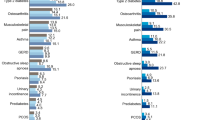Abstract
OBJECTIVE: This study investigated whether medically significant obesity (body mass index>30 kg/m2) is recognised effectively in hospital outpatient departments and how those identified as obese are subsequently managed.
DESIGN: A retrospective analysis of patients' hospital records (rheumatology n=108, cardiology n=257, orthopaedic n=250) established the reported prevalence of obesity and subsequent referral patterns. In addition, BMI was measured prospectively on a separate cohort (rheumatology n=188, cardiology n=203, orthopaedic n=179) to determine the true prevalence.
RESULTS: Generally, obesity management appeared minimal and inconsistent. Retrospective analysis revealed an apparently low rate of obesity (4% cardiology, 5% rheumatology and 3% orthopaedics), whilst the true prevalence was found to be 30% for cardiology, 25.1% for orthopaedics and 20.2% for rheumatology. Although this appears to show a large disparity between the apparent and the true prevalence, it is impossible to establish precisely the degree of under-estimation, as the lack of height measurements (14% only) in the retrospective sample affects the reliability of the apparent prevalence. Further comparison with the general population showed obesity to be particularly common in men attending cardiology clinics.
CONCLUSION: An outpatient clinic consultation could be a useful starting point for integrating obesity and disease management, by helping to identify obesity, initiate appropriate referrals and assist in obesity education.
This is a preview of subscription content, access via your institution
Access options
Subscribe to this journal
Receive 12 print issues and online access
$259.00 per year
only $21.58 per issue
Buy this article
- Purchase on Springer Link
- Instant access to full article PDF
Prices may be subject to local taxes which are calculated during checkout
Similar content being viewed by others
References
Health Survey for England 1997 In: Health of the nation Department of Epidemiology and Public Health, University College: London 1999.
Williams G . Obesity and type 2 diabetes: conflict of interests? Int J Obes Relat Metab Disord 1999 23(Suppl 7): S2–S4.
Jung RT . Obesity as a disease Br Med Bull 1997 53: 264–285.
Hughes D, McGuire A, Ellot H, Finer N, Lean M, Prentice A, Ritchie M . The cost of obesity in the United Kingdom J Med Econ 1999 2: 143–153.
Goldstein DJ . Beneficial health effects of modest weight loss Int J Obes Relat Metab Disord 1992 16: 397–415.
Lean MEJ, Powrie JK, Anderson AS, Garthwaite PH . Obesity, weight loss and prognosis in type 2 diabetes Diabetic Med 1990 7: 228–233.
Deurenberg P, Weststrate JA, Seidell JC . Body mass index as a measure of body fatness: age-and-sex-specific prediction formulas Br J Nutr 1991 65: 105–114.
WHO Study Group . Defining the problem of overweight and obesity In: Obesity: preventing and managing the global epidemic Report of a WHO consultation on obesity. WHO: Geneva 1997 7–16.
Health Survey for England: cardiovascular disease'98 Department of Epidemiology and Public Health, University College: London 1999.
Lean MEJ, Hans TS, Morrison CE . Waist circumference indicates the need for eight management Br Med J 1995 311: 158–161.
Han TS, Leer EM, Seidell JC, Lean MEJ . Waist circumference action levels in the identification of cardiovascular risk factors: prevalence study in a random sample Br Med J 1995 311: 1401–1405.
Department of Health . National Service Framework for Coronary Heart Disease: modern standards and service models Department of Health: London March 2000.
Eckel RH . Obesity and Heart Disease. A statement for healthcare professionals from the Nutrition Committee, American Heart Association Circulation 1997 96: 3248–3250.
Kopelman PG . Emerging management strategies for obesity Int J Obes Relat Metab Disord 1998 22(Suppl 1): S7–S11.
Acknowledgements
We particularly thank the clinical directors of cardiology, rheumatology and orthopaedics and the nursing staff of the outpatient department for their cooperation throughout this study.
Author information
Authors and Affiliations
Corresponding author
Rights and permissions
About this article
Cite this article
Cleator, J., Richman, E., Leong, K. et al. Obesity: under-diagnosed and under-treated in hospital outpatient departments. Int J Obes 26, 581–584 (2002). https://doi.org/10.1038/sj.ijo.0801945
Received:
Revised:
Accepted:
Published:
Issue Date:
DOI: https://doi.org/10.1038/sj.ijo.0801945
Keywords
This article is cited by
-
Orthopaedic patients underestimate their body weight too: a cross-sectional study
International Orthopaedics (2021)
-
BMI-based body size guides for women and men: development and validation of a novel pictorial method to assess weight-related concepts
International Journal of Obesity (2008)



